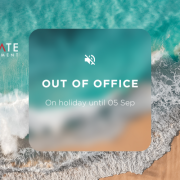Out of office response tips
Taking some time off for a holiday or heading out on a work trip? An Out of Office (OOO) message is a must for letting your clients, suppliers, and colleagues know you’re away from your desk.
Writing an Out of Office message might seem pretty easy, but anyone who has sat there with a blank email knows it can be harder than it seems. Should you keep it light, professional, or straight to the point? And what about setting different messages for internal versus external contacts?
We’ve pulled together our tips for crafting the perfect OOO. No matter why you’re away, this guide has got you covered.
When to Set an Out of Office Email: Use an OOO message anytime you’ll be away from your emails longer than usual and won’t be able to respond promptly. Not sure what is expected in your workplace? Check with your manager or HR, as many companies have policies about when and how to use OOO messages, including what information to include. It’s a good idea to review these guidelines before setting up your auto-reply.
What Makes a Good Out of Office Email? A solid OOO message is brief and to the point, giving the reader all the necessary info in just a few sentences. Some prefer a direct approach, while others like to add a bit of personality or humor. We’ve included some examples of both styles to help you decide how to write your own message.
Five Tips for Writing the Best Out of Office Messages The most effective OOO messages are clear, concise, and professional, yet they still have a personal touch. Here are some tips to help you hit the right balance:
- Keep It Clear Your message should be straightforward and easy to understand. Get to the point: your leave dates, expected return date, an alternate contact, and when you’ll be checking your emails again.
- Keep It Short Aim to keep your message brief and organised. If you need to include multiple points of contact or other details, consider using bullet points. If it’s not essential, leave it out.
- Keep It Friendly Even if you’re away, your OOO message should reflect your professionalism. Double-check your spelling and grammar, and make sure you’re comfortable with anyone receiving your message.
- Keep It Human Your message doesn’t have to sound robotic. Be polite, use a friendly tone, and consider addressing recipients by name if your email system allows it. Also, provide an alternate contact in case someone needs assistance before you return.
- Keep It Light A touch of humor can make your OOO message more engaging, but use it wisely. Avoid sarcasm, as it can easily be misunderstood. A light-hearted pun or a bit of warmth can add personality without compromising professionalism.
Examples for Different Situations Still not sure what to write? These OOO templates can serve as a starting point. Just remember to personalise them to suit your tone and situation.
Setting an OOO Email for Annual Leave When you’re on annual leave, your OOO message should be clear and concise, letting people know when you’ll be back and who they can contact in your absence.
Template: “Hi there,
I’m currently on annual leave from [Leave-Date] to [Return-Date] and won’t be checking emails during this time. For urgent matters, please contact [Colleague-Name] at [Phone-Number] or [Email-Address]. I’ll get back to you when I return.
Kind regards,
[Your-Name]”
Setting an OOO Email for Business Travel If you’re travelling for work, it’s good to let people know that your email responses might be delayed.
Template: “Hi,
I’m out of the office on a business trip with limited access to email from [Leave-Date] to [Return-Date]. For immediate assistance, please reach out to [Colleague-Name] at [Phone-Number] or [Email-Address] or I’ll reply on my return.
Best regards,
[Your-Name]”
Setting an OOO Email for Medical Leave If you’re on medical leave, your message should be informative but brief, providing an alternate contact for urgent matters.
Template: “Hello,
I’m currently on medical leave from [Date] and unable to access my email. I plan to return on [Date], but in the meantime, [Colleague-Name] is available to assist you. Please contact them at [Phone] or [Email].
Thank you,
[Your-Name]”
Setting an OOO Email for a Family Emergency In the event of a family emergency, your OOO message should be both professional and empathetic, directing people to someone who can help in your absence.
Template: “Hi there,
Due to a family emergency, I’m out of the office from [Date] and will return on [Date]. If you need assistance before then, please contact [Colleague-Name] at [Phone] or [Email].
Thank you,
[Your-Name]”
Setting an OOO Email with some humour – Maybe best kept for internal replies
Template: “Hi there,
I’m currently out of the office, relaxing on a sun lounger sipping coffee/cocktails in [Date]. I’ll be back on [Date], hopefully refreshed and not too sunburned.
In the meantime [Colleague-Name] at [Phone] or [Email] is bravely handling my queries. If your request is not urgent, I’ll get back to you on my return, probably with travel stories to share!
Cheers
[Your-Name]
Best Practices for Out of Office Messages Setting up an OOO message is a small step that can have a big impact on how you’re perceived while you’re away. Here are a few best practices to keep in mind:
- Set it up in advance: Schedule your OOO message as soon as you know your leave dates, so you don’t forget.
- Include exact dates, if possible: If you know your return date, include it in your message. Some people extend their OOO timeframe by a day or two to allow for catching up.
- Provide alternate contacts: Make sure to include a colleague’s contact details for any urgent matters.
- Different messages for different audiences: If your email system allows, set up separate OOO messages for internal and external contacts, tailoring your tone and information accordingly.


